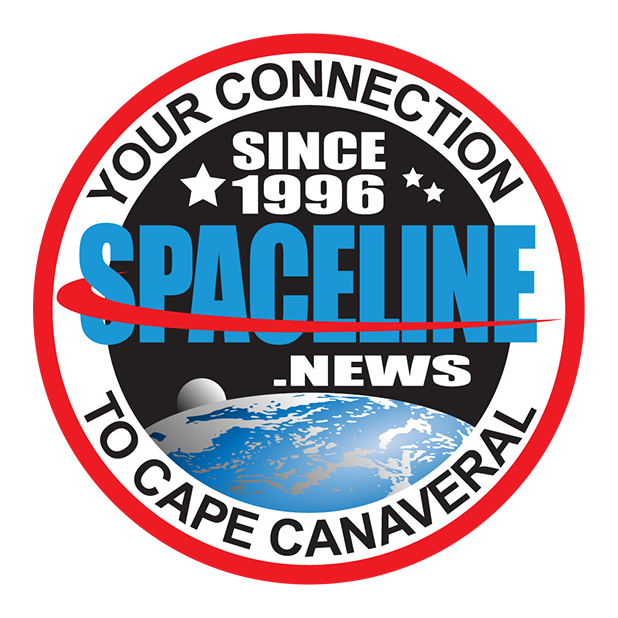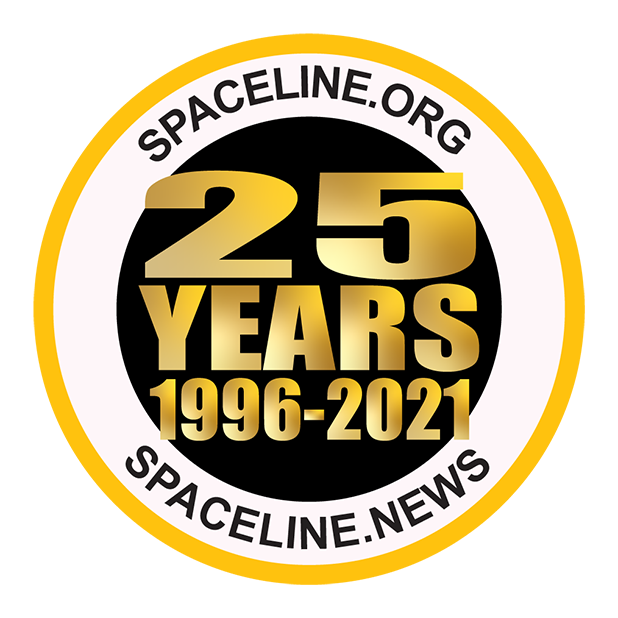
Falcon 9 Starlink Launch, Photo Courtesy SpaceX
Falcon 9 Successfully Launches 60 SpaceX Starlink Broadband Satellites
January 29, 2020 | Reported by Cliff Lethbridge
A SpaceX Falcon 9 rocket successfully launched 60 Starlink broadband satellites at 9:06 a.m. EST today from Launch Pad 40 on Cape Canaveral Air Force Station. This was the fourth batch of 60 satellites launched in the SpaceX Starlink broadband satellite constellation to date. Launch was postponed over a week due to high winds and seas in the booster recovery area. The first actual launch attempt on January 27 was scrubbed due to unacceptable high altitude winds. The Falcon 9 first stage booster employed today was being flown for the third time, having previously supported the first Crew Dragon demonstration flight in March, 2019 and the RADARSAT mission in June, 2019. The booster was successfully recovered with a landing on the "Of Course I Still Love You" drone ship positioned on the Atlantic Ocean about 400 miles northeast of Cape Canaveral. The "Ms. Tree" vessel successfully caught half of the Falcon 9 payload fairing, but an attempt to catch the other half by the "Ms. Chief" vessel was unsuccessful. The 60 Starlink satellites were deployed at an altitude of 290 kilometers about an hour after launch. Over the course of one to four months the satellites will use their on-board thrusters to raise their altitude to 550 kilometers. The Starlink constellation is designed to provide space-based Internet access to areas without service, or as an alternative to traditional Internet providers. Pricing of the service has yet to be determined, but Starlink may be operational later this year depending on how many satellites can be launched.

Falcon 9 Starlink In-Flight Halo Effects, Photo Courtesy Lloyd Behrendt/Spaceline

Falcon 9 Crew Dragon Launch, Photo Courtesy NASA
SpaceX Successfully Conducts Crew Dragon In-Flight Abort Test
January 19, 2020 | Reported by Cliff Lethbridge
In the final hurdle prior to manned flights, SpaceX today successfully conducted an in-flight abort test of its Crew Dragon space capsule. A fully functioning Crew Dragon spacecraft poised atop a Falcon 9 rocket was launched from Launch Pad 39A at the Kennedy Space Center at 10:30 a.m. EST. Launch was originally scheduled for January 18 but was postponed 24 hours due to high winds and seas in the Crew Dragon recovery area off Cape Canaveral. Today's launch was delayed 2.5 hours to allow high winds to die down in the recovery area. The Falcon 9 rocket was launched on a trajectory it would follow if launched to the International Space Station. A cutoff of the Falcon 9 engines was triggered at 1.5 minutes into the flight at an altitude of about 30,000 feet at the point of "Max Q", or the point of maximum dynamic stress on the launch vehicle during ascent. At that point, the Crew Dragon spacecraft separated from the launch vehicle, carried away by a firing of its Super Draco thrusters. Not long after separation, the Falcon 9 booster exploded in a fireball. The violent explosion did not adversely affect the flight path of Crew Dragon.

Falcon 9 Booster Explodes, Photo Courtesy Reuters
Following Super Draco shutdown, the spacecraft coasted unpowered to its highest point at an altitude of about 100,000 feet. Smaller Draco thrusters were then fired to re-orient the spacecraft for reentry and parachute deploy. Ultimately, the Crew Dragon drogue and main parachutes were deployed and the spacecraft made a soft landing on the Atlantic Ocean about 20 miles east of Cape Canaveral about 8 minutes after launch. Upon landing, Air Force personnel approached the spacecraft to rehearse astronaut rescue operations. Crew Dragon was recovered by a specialized SpaceX vessel for a return to Cape Canaveral for analysis and processing. SpaceX also dispatched vessels to retrieve debris from the Falcon 9 breakup, from which one especially large segment crashed onto the ocean, creating a fireball and huge mushroom cloud. Today's successful test paves the way for future manned Crew Dragon flights under the NASA Commercial Crew Program, the first of which may occur this spring.

Large Falcon 9 Booster Fragment Falls To Ocean, Photo Courtesy Lloyd Behrendt/Spaceline

Falcon 9 Starlink Launch, Photo Courtesy SpaceX
Falcon 9 Successfully Launches 60 SpaceX Starlink Broadband Satellites
January 6, 2020 | Reported by Cliff Lethbridge
A SpaceX Falcon 9 rocket successfully launched 60 Starlink broadband satellites at 9:19 p.m. EST today from Launch Pad 40 on Cape Canaveral Air Force Station. This was the third batch of 60 satellites launched in the SpaceX Starlink broadband satellite constellation to date. The first stage booster employed today was being flown for the fourth time, having previously supported the Starlink launch in May, 2019, the Iridium-8 launch in January, 2019 and the Telstar-18 VANTAGE launch in September, 2018. The booster was successfully recovered with a landing on the "Of Course I Still Love You" drone ship positioned on the Atlantic Ocean about 400 miles northeast of Cape Canaveral. An at-sea attempt to recover half of the rocket's payload fairing was not successful. The 60 Starlink satellites were deployed at an altitude of 290 kilometers about an hour after launch. Over the course of one to four months the satellites will use their on-board thrusters to raise their altitude to 550 kilometers. The Starlink constellation is designed to provide space-based Internet access to areas without service, or as an alternative to traditional Internet providers. Pricing of the service has yet to be determined, but Starlink may be operational later this year depending on how many satellites can be launched.

Falcon 9 Starlink At Main Engine Cutoff, Photo Courtesy Lloyd Behrendt/Spaceline








